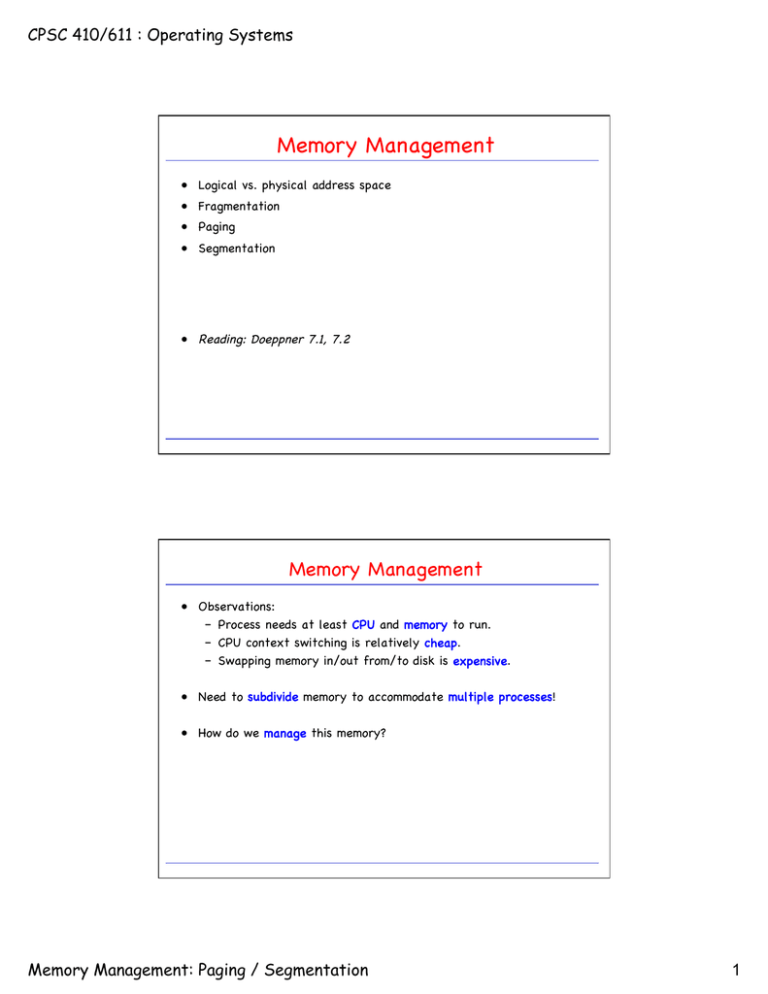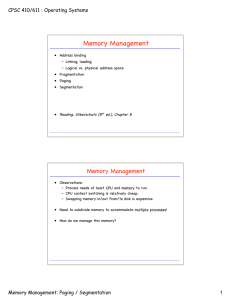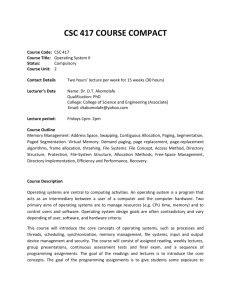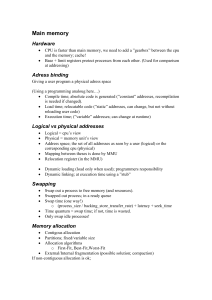Memory Management! CPSC 410/611 : Operating Systems
advertisement

CPSC 410/611 : Operating Systems Memory Management! • Logical vs. physical address space! • Fragmentation! • Paging! • Segmentation! • Reading: Doeppner 7.1, 7.2! Memory Management! • Observations:! – Process needs at least CPU and memory to run.! – CPU context switching is relatively cheap.! – Swapping memory in/out from/to disk is expensive.! • Need to subdivide memory to accommodate multiple processes!! • How do we manage this memory?! Memory Management: Paging / Segmentation 1 CPSC 410/611 : Operating Systems Requirements for Memory Management! • Relocation! – We do not know a priori where memory of process will reside.! • Protection! – No uncontrolled references to memory locations of other processes.! – Memory references must be checked at run-time.! • Sharing! – Data portions and program text portions.! • Logical organization! – Take advantage of semantics of use.! – Data portions (read/write) vs. program text portions (read only).! • Memory hierarchy! – RAM vs. secondary storage! – Swapping! Logical vs. Physical Memory Space! • Logical address: address as seen by the process (i.e. as seen by the CPU).! • Physical address: address as seen by the memory.! limit register < CPU logical address space of process Pi relocation register OS physical address space of process Pi + addressing error! Memory Management Unit partition table process P1 P2 P3 base 28 1028 5034 Physical Memory size 1000 3000 250 Memory Management: Paging / Segmentation 2 CPSC 410/611 : Operating Systems Swapping! swap_out OS swap_in start swapping store ready ready_sw memory running waiting_sw waiting jobs are on disk jobs are in memory Fragmentation! Internal Fragmentation! OS 8MB 2MB 4MB ?! 8MB 12MB External Fragmentation! P1 P1 P1 P2 P2 P3 Memory Management: Paging / Segmentation P1 P3 ? P4 3 CPSC 410/611 : Operating Systems Paging! • Contiguous allocation causes (external) fragmentation.! • Solution: Partition memory blocks into smaller subblocks (pages) and allow them to be allocated non-contiguously.! simple relocation Memory Management Unit logical memory paging physical memory Memory Management Unit logical memory physical memory Basic Operations in Paging Hardware! CPU p d f d p d f page table Memory Management Unit physical memory Example: PDP-11 (16-bit address, 8kB pages) Memory Management: Paging / Segmentation 4 CPSC 410/611 : Operating Systems Internal Fragmentation in Paging! • Example:! page size 4kB logical memory 13300B 4084 bytes wasted! physical memory • Last frame allocated may not be completely full. • Average internal fragmentation per block is typically half frame size. • Large frames vs. small frames: • Large frames cause more fragmentation. • Small frames cause more overhead (page table size, disk I/O) Implementation of Page Table! • Page table involved in every access to memory. Speed very important.! • Page table in registers?! – Example: 1MB logical address space, 2kB page size; needs a page table with 512 entries!! • Page table in memory?! – Only keep a page table base register that points to location of page table.! – Each access to memory would require two accesses to memory! ! • Cache portions of page table in registers?! – Use translation lookaside buffers (TLBs): typically a few dozens entries.! – Hit ratio: Percentage of time an entry is found.! Hit ratio must be high in order to minimize overhead.! Memory Management: Paging / Segmentation 5 CPSC 410/611 : Operating Systems Hierarchical (Multilevel) Paging! • Problem: Page tables can become very large! (e.g. 32-bit address space?)! • Solution: Page the page table itself! (e.g. page directory vs. page table)! • Two-level paging:! – Example: 32 bit logical address, page size 4kB! page directory (10) page table (10) page table base register offset(12) f d f • Three-level paging (SPARC), four-level paging (68030), ...! • AMD64 (48-bit virtual addresses) has 4 levels.! • Even deeper for 64 bit address spaces (5 to 6 levels)! Variations: Inverted Page Table! proc id process id! page no offset page no! 0! 1! 2! 3! 3 offset …! n! • Array of page numbers indexed by frame number.! – page lookup: search for matching frame entry! • Size scales with physical memory.! • Single table for system (not per process)! • Used in early virt. memory systems, such as the Atlas computer.! • Not practical today. (Why?)! Memory Management: Paging / Segmentation 6 CPSC 410/611 : Operating Systems Variations: Hashed Page Table! page number • Used by many 64bit architectures:! – IBM POWER! – HP PA-RISC! – Itanium! • Scales with physical memory! • One table for whole system! • Difficult to share memory between processes! offset hash function proc id page no chain Software-loaded TLBs: Paging - MIPS Style! Process no. Program (virtual) address ASID Address within page VPN TLB Page table (in memory) ASID VPN/Mask PFN Flags PFN Flags refill when necessary Physical address PFN Memory Management: Paging / Segmentation Address within frame 7 CPSC 410/611 : Operating Systems Recap: Memory Translation -- “VAX style”! 1. Split virtual address! 2. Concatenate more-significant bits with Process ASID to form page address.! 3. Look in the TLB to see if we find translation entry for page.! 4. If YES, take high-order physical address bits.! – (Extra bits stored with PFN control the access to frame.)! 5. If NO, system must locate page entry in main-memoryresident page table, load it into TLB, and start again. ! Memory Translation -- MIPS Style! • In principle: Do the same as VAX, but with as little hardware as possible.! • Apart from register with ASID, the MMU is just a TLB.! • The rest is all implemented in software!! • When TLB cannot translate an address, a special exception (TLB refill) is raised.! • Note: This is easy in principle, but tricky to do efficiently.! Memory Management: Paging / Segmentation 8 CPSC 410/611 : Operating Systems MIPS TLB Entry Fields! input output VPN ASID • VPN: higher order bits of virtual address! • ASID: identifies the address space! • G: if set, disables the matching with the ASID! G PFN N Flags D V • PFN: Physical frame number! • N: 0 - cacheable, 1 noncacheable! • D: write-control bit (set to 1 if writeable)! • V: valid bit! MIPS Translation Process! 1. CPU generates a program (virtual) address on a instruction fetch, a load, or a store.! 2. The 12 low-end bits are separated off.! 3. Case 1: TLB matches key: ! 1. Matching entry is selected, and PFN is glued to low-order bits of the program address.! 2. Valid?: The V and D bits are checked. If problem, raise exception, and set BadVAddr register with offending program address.! 3. Cached?: IF C bit is set, the CPU looks in the cache for a copy of the physical location’s data. If C bit is cleared, it neither looks in nor refills the cache.! 4. Case 2: TLB does not match: TLB Refill Exception (see next page)! Memory Management: Paging / Segmentation 9 CPSC 410/611 : Operating Systems TLB Refill Exception! • Figure out if this was a correct translation. If not, trap to handling of address errors.! • If translation correct, construct TLB entry.! • If TLB already full, select an entry to discard.! • Write the new entry into the TLB.! Segmentation! • Users think of memory in terms of segments (data, code, stack, objects, ....)! • Data within a segment typically has uniform access restrictions.! paging Memory Management Unit logical memory segmentation physical memory Memory Management Unit logical memory Memory Management: Paging / Segmentation physical memory 10 CPSC 410/611 : Operating Systems Segmentation Hardware! CPU s d <? + s limit base segment table Memory Management Unit physical memory Advantages of Segmentation! • Data in a segment typically semantically related! • Protection can be associated with segments! – read/write protection! – range checks for arrays! • Data/code sharing! • Disadvantages?! s <? d s s limit s limit Memory Management: Paging / Segmentation + base <? d sharing base + physical! memory! 11 CPSC 410/611 : Operating Systems Solution: Paged Segmentation! • Example: MULTICS! segment number offset 18bit 16bit Problem: 64kW segments -> external fragmentation! Solution: Page the segments. page segment number page# offset 18bit 6bit 10bit Problem: need 2^18 segment entries in segment table! Solution: Page the segment table. page# 8bit page page page# offset offset 10bit Memory Management: Paging / Segmentation 6bit 10bit 12



